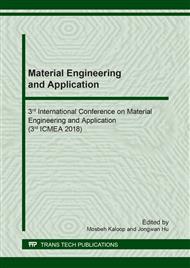[1]
W. Martinez-Molina, A. Torres-Acosta, R. Hernandez-Leos, E. Alonso-Guzman, I. Mendoza-Pérez, I. Martinez-Peña, The inhibitive properties of Nopal slime on the corrosion of Steel in chloride-contaminated mortar, Anti-Corrosion Methods and Materials. 23 (2016) 65-71.
DOI: 10.1108/acmm-05-2014-1381
Google Scholar
[2]
Y. Aguila, Idalberto, M. Soso, Chemical evaluation of the ashes of wheat husk, cane bagasse and corn leaves and their influence in the mortar mixtures, like pozzolan materials. Universidad Central de Venezuela: School of Engineering Magazine, (2008).
Google Scholar
[3]
D. Sánchez de Guzman, Concretes and mortars, Colombia: Instituto del Concreto, (2006).
Google Scholar
[4]
J. I. Alvarez Galindo, History of Mortars, En F. d. Chemistry and Pedology Department, Materials and Techniques, Universidad de Navarra, Spain, 1995, pp.52-59.
Google Scholar
[5]
R. J. Detwiler, P. K. Mehta, Chemical and physical effects of silica fume on the mechanical behaviour of concrete. ACI. Mater. J. 86(1989), 609.
Google Scholar
[6]
P.K. Mehta, Influence of fly ash characteristics on the strength of Portland-fly ash mixtures, Cem. Concr. Res. 15 (1985) 669.
DOI: 10.1016/0008-8846(85)90067-5
Google Scholar
[7]
A. Goldman, A. Bentur, The influence of microfillers on enhancement of concrete strength, Cem. Concr. Res. 23 (1993) 962.
DOI: 10.1016/0008-8846(93)90050-j
Google Scholar
[8]
P. Chindaprasirt, C. Jaturapitakkul, T. Sinsiri, Effect of fly ash fineness on microstructure of blended cement paste, Constr. Build. Mater. 21 (2007) 1534.
DOI: 10.1016/j.conbuildmat.2005.12.024
Google Scholar
[9]
V. Sata, C. Jaturapitakkul, K. Kiatttikomol, Influence of pozzolan from various by-product materials on mechanical properties of high strength concrete, Constr. Build. Mater. 21 (2007) 1589.
DOI: 10.1016/j.conbuildmat.2005.09.011
Google Scholar
[10]
S. Rukzon, P. Chindaprasirt, R. Mahachai, Effect of grinding on chemical and physical properties of rice husk ash, Int. J. Miner. Metal. Mater. 16 (2009) 242.
DOI: 10.1016/s1674-4799(09)60041-8
Google Scholar
[11]
C. Bernabe Reyes, Evaluation of mortars in cement substitutes with pozzolan ashes to mitigate the corrosion phenomenon in concrete rehabilitation, Master's Thesis, School of Civil Engineering, Universidad Michoacana de San Nicolas de Hidalgo, Morelia, Mexico, (2015).
DOI: 10.21041/conpat2019/v1cc119
Google Scholar
[12]
H. L. Chávez-García, E. M. Alonso-Guzmán, W. Martínez-Molina, M. Graff, J. C. Arteaga-Arcos, Prediction of the static modulus of elasticity using four non-destructive testing, Construction Magazine. 13 (2014), 33-40.
DOI: 10.4067/s0718-915x2014000100004
Google Scholar
[13]
W. Martinez-Molina, A. A. Torres-Acosta, J. C. Jáuregui, H. L. Chávez García, E. Alonso-Guzman, M. Graff, J. C. Arteaga-Arcos, Predicting concrete compressive strength and modulus of rupture using different NDT techniques, Advances in Materials Science and Engineering.
DOI: 10.1155/2014/742129
Google Scholar
[14]
V. H. Blancas Herrera, Physical and mechanical evaluation and by criteria of durability of cement matrixes with organic substitutions, Bachelor's Thesis, School of Civil Engineering, Universidad Michoacana de San Nicolas de Hidalgo, Morelia, Mexico, (2017).
DOI: 10.21041/conpat2019/v1cc109
Google Scholar


